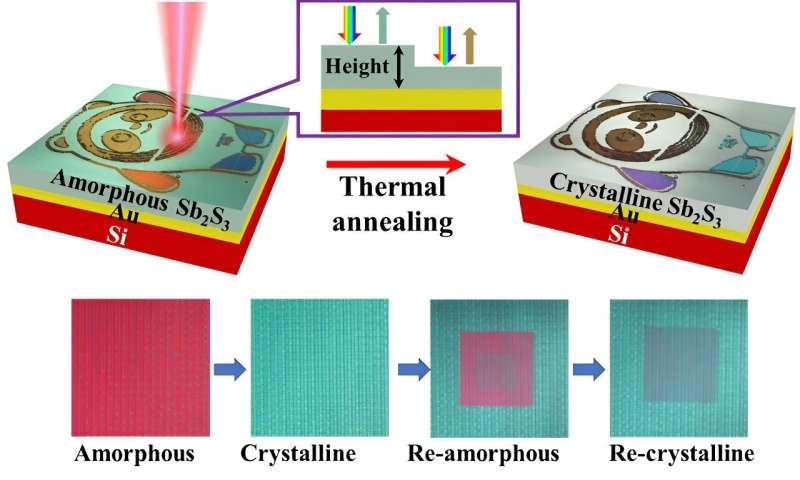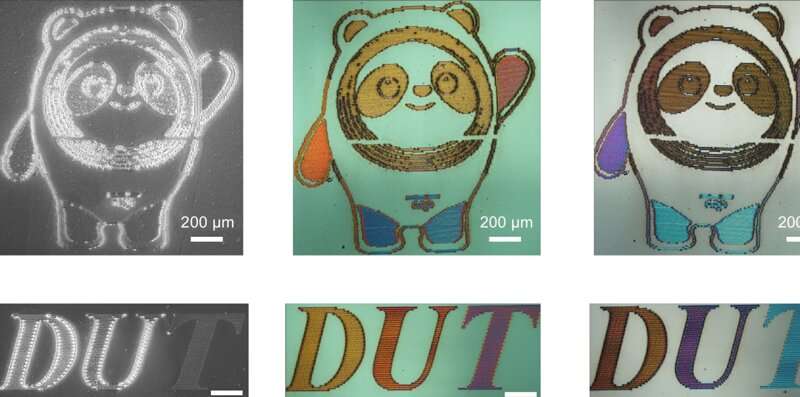Non-volatile dynamically switchable color display via chalcogenide stepwise cavity resonators

Traditional color display technology uses dyes, pigments and other color absorbing materials for spectral filtering and color development, which has problems including low lifetime, fading, not environmental-friendly, color crosstalk, etc. This causes color absorbing materials to face greater challenges in high-resolution display, imaging and other applications.
Compared with the traditional color development technology, the color generated by the structure—called structural color—which includes rainbows and soap bubbles, peacock feathers and butterfly wings, etc., is characterized by higher brightness, smaller size, and fastness, and it is environmental-friendly.
This structural color has great advantages in color display, imaging technology and anti-counterfeiting technology. With the development of nano-manufacturing technology, artificial nanostructures such as metamaterials and metasurfaces with a high-degree of freedom from spectral regulation provide a new technical means for creating structural color.
However, most studies on structural color focus on the design of geometric features such as the size, shape and period of the unit cell. Based on physical mechanisms such as plasmon resonance, a variety of colors are generated by changing the design. Once the design is determined, the color cannot be dynamically changed.
Structural colors with dynamic control ability therefore have become an important development direction. At present, the display technology based on the dynamic adjustable optical parameters such as liquid crystal molecules has shown the ability to dynamically control the structural color, but its problems are centered on volatile colors, high energy consumption and slow response, which greatly limit its application. Therefore, achieving non-volatile, fast, dynamic display is still a challenge.
The research group of Prof. Tun Cao from Dalian University of Technology, together with the research group of Prof. Minghui Hong from Xiamen University, has proposed a non-volatile dynamic display technology based on the stepwise resonance cavity of chalcogenide. They have experimentally realized a lithography-free dynamically switchable color reflector by incorporating chalcogenide within an asymmetric stepwise pixelated Fabry–Pérot (FP) cavity array.
The paper is published in the journal Opto-Electronic Advances.
More explicitly, the femtosecond (fs) laser has been employed to fabricate the asymmetric FP cavity array consisting of the stepwise chalcogenide film sandwiched by a 100 nm thick gold reflector and air. They have demonstrated that the height of the chalcogenide film cavity can be engineered by modulating the power of fs laser irradiation.
These pixelated FP cavities with various cavity height (namely the thickness of chalcogenide film) can produce a robust, vivid color palette due to the interaction of the light in the multilayered structure. The reflectance can be continuously tuned over the whole visible spectrum by engineering the thickness of the chalcogenide layer within the cavity.
Based on unique non-volatile and reversible properties of phase transition in chalcogenide, the chalcogenide is used as the active dielectric to dynamically modulate the reflected color by transiting the state of chalcogenide with fs laser pulses.

They have presented a dynamic color microprint of "Bing Dwen Dwen" from the Beijing Winter Olympics 2022, illustrating the possibility of making arbitrary dynamic microprints. Moreover, their color reflector does not need any complex lithographic techniques during the fabrication, which significantly reduces the complexity and device cost.
These color-varying devices based on the chalcogenide phase change materials may pave the way toward the next generation of inkless erasable papers or displays and offer camouflaging surfaces, compact systems, and signaling to engineer the spectrum of visible light.
More information:
Kuan Liu et al, Non-volatile dynamically switchable color display via chalcogenide stepwise cavity resonators, Opto-Electronic Advances (2024). DOI: 10.29026/oea.2024.230033
Provided by Compuscript Ltd